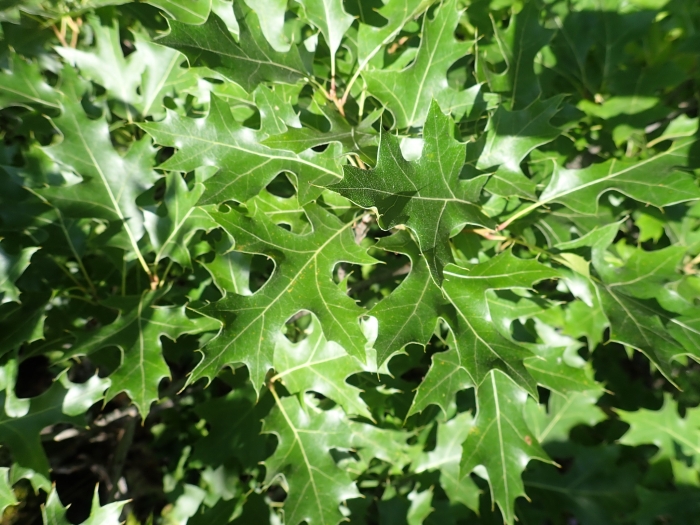Northern Pin Oak
(Quercus ellipsoidalis)
Northern Pin Oak (Quercus ellipsoidalis)
/
/

Rob Foster
CC BY 4.0
Image By:
Rob Foster
Recorded By:
Copyright:
CC BY 4.0
Copyright Notice:
Photo by: Rob Foster | License Type: CC BY 4.0 | License URL: http://creativecommons.org/licenses/by/4.0/ | Rights Holder: Rob Foster | Publisher: iNaturalist | Date Created: 2019-07-20T16:07:58-07:00 |


























































Estimated Native Range
Summary
Quercus ellipsoidalis, commonly known as Northern Pin Oak, is a deciduous tree native to dry upland forests, sandy plains, and savannas in the Midwestern United States and Ontario. It grows to a height of 66 feet (20 meters) with an open, rounded crown, and is recognized for its deeply lobed, glossy green leaves that turn a brilliant red in the fall. The acorns are distinctive, typically ellipsoid in shape, but can vary to globose, with a third to a half covered in a deep cup that matures from green to pale brown approximately 18 months after pollination. The kernel is notably bitter, and the inner surface of the acorn cap ranges from hairless to moderately pubescent with potential kinky hairs.
Northern Pin Oak is valued for its striking fall coloration and its adaptability to poor, sandy soils, making it a popular choice for ornamental planting in urban landscapes, parks, and gardens. It thrives in full sun and requires low to medium amounts of water, preferring well-drained soils. While it is tolerant of infertile soils, it may exhibit iron chlorosis in high pH soils, leading to yellowing leaves. This species is less commonly used than other oaks due to its specific soil requirements and potential for chlorosis.CC BY-SA 4.0
Northern Pin Oak is valued for its striking fall coloration and its adaptability to poor, sandy soils, making it a popular choice for ornamental planting in urban landscapes, parks, and gardens. It thrives in full sun and requires low to medium amounts of water, preferring well-drained soils. While it is tolerant of infertile soils, it may exhibit iron chlorosis in high pH soils, leading to yellowing leaves. This species is less commonly used than other oaks due to its specific soil requirements and potential for chlorosis.CC BY-SA 4.0
Plant Description
- Plant Type: Tree
- Height: 50-70 feet
- Width: 40-60 feet
- Growth Rate: Moderate
- Flower Color: N/A
- Flowering Season: Spring
- Leaf Retention: Deciduous
Growth Requirements
- Sun: Full Sun
- Water: Low, Medium
- Drainage: Medium, Fast
Common Uses
Bee Garden, Bird Garden, Butterfly Garden, Drought Tolerant, Rabbit Resistant
Natural Habitat
Dry upland forests, sandy plains, and savannas
Other Names
Common Names: Jack Oak, Hill’s Oak, Chêne Ellipsoïdal
Scientific Names: , Quercus ellipsoidalis, Quercus ellipsoidalis var. coccinioides, Quercus ellipsoidalis var. kaposianensis, Quercus ellipsoidalis f. ellipsoidalis, Quercus ellipsoidalis f. heterophylla, Quercus ellipsoidalis f. incurva,
GBIF Accepted Name: Quercus ellipsoidalis E.J.Hill